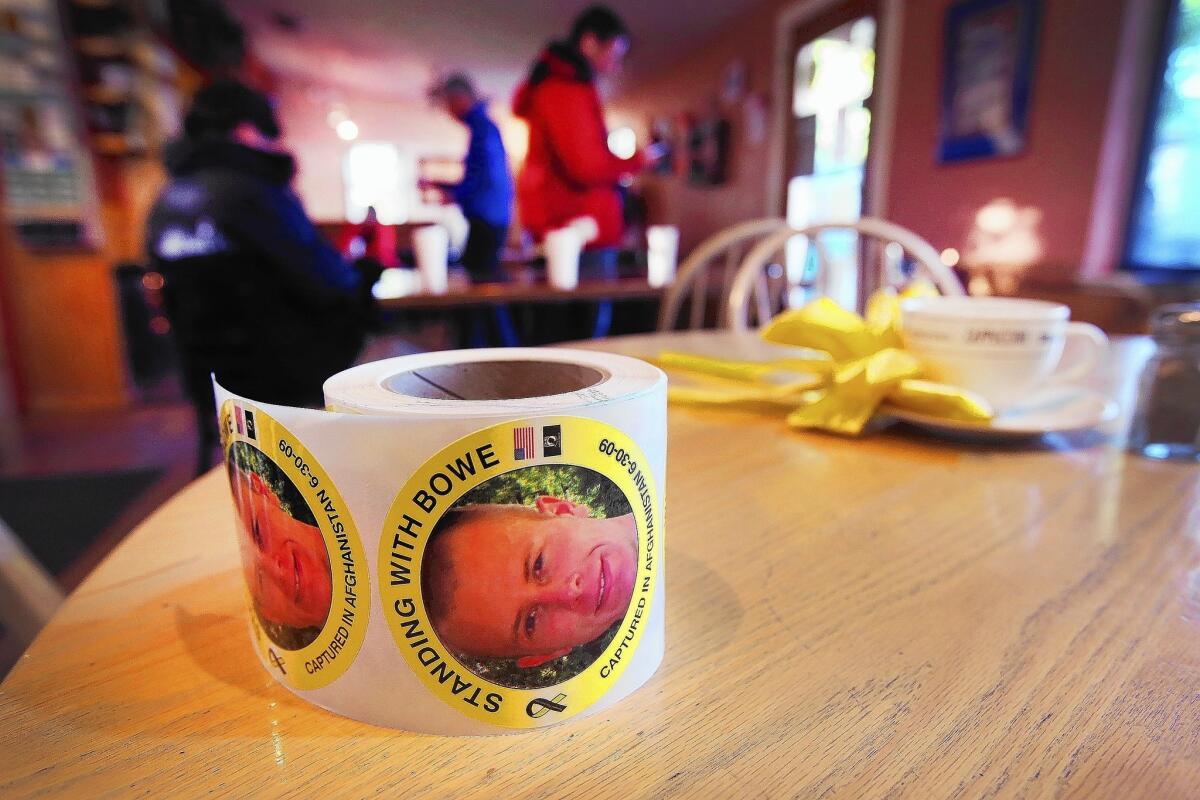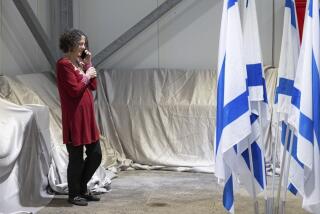U.S. soldier’s hometown has a certain radiance

- Share via
Reporting from HAILEY, Idaho — Day and night for five long years the tiny light has burned inside the rustic coffeehouse. When patrons jostled the lamp from its post by the front door, workers moved it atop a corner cabinet where it has remained this small town’s beacon of hope that its captured soldier might one day return home.
Since 2009, this isolated north woods community of 7,000 residents has endured a jarring absence: Bowe Bergdahl, the idealistic and hyper-athletic son of the local UPS deliveryman, had been taken captive by Taliban extremists in Afghanistan while serving in an Alaska-based infantry regiment. The only hint on his condition came in the proof-of-life videos of Bowe released by his captors.
Other constants emerged. Yellow ribbons and banners became mainstays here, along with the Norway maple trees, one for each year of Bergdahl’s captivity, planted at a local park.
There was the long hair and backwoods beard sprouted by a normally clean-shaven Bob Bergdahl in solidarity with his son — facial hair that became longer and more ragged with each year.
And there were the supporters at Zaney’s coffeehouse, where Bowe once served customers. For nearly 60 months, the place was a clearinghouse for all things Bowe, the meeting spot to talk strategy and plan upcoming solidarity events.
It was a refuge to sit and wait. And hope. And on Monday, to celebrate.
Days after the announcement that the 28-year-old Army sergeant had been freed in a controversial prisoner swap orchestrated by the Obama administration, Zaney’s owner Sue Martin gestured at the lamp. “I can’t tell you what that light means for people in this town,” said the 64-year-old grandmother in sneakers and bluejeans who has served as the Bergdahl family’s spokeswoman. “It refused to go out.”
Hailey’s yellow ribbons and Bowe bracelets now include signs proclaiming “Bowe is free at last!” Folks know he is recuperating at a hospital in Germany — disoriented, having forgotten some of his English.
“How often does this happen?” asked hotel worker Adam Marks, 22. “Someone snatched by the enemy in a foreign land, and then they’re let go? There were times I doubted he was even alive. But a lot of people here didn’t lose their faith at all.”
Along with Hailey’s collective relief has surfaced renewed talk of the mystery surrounding Bergdahl’s capture. Several former members of his platoon have publicly stated Bergdahl willingly walked away. “Bowe Bergdahl deserted during a time of war, and his fellow Americans lost their lives searching for him,” former Sgt. Matt Vierkant told CNN.
Hailey Mayor Fritz Haemmerle said in an interview that he had received dozens of calls and emails from around the nation, many of them reasoned, others not.
“There have also been some fairly articulate emails from local people who have served and are concerned that we’re portraying this as a hero’s welcome, which it’s not,” he said. “Our position is that every kid who serves his country needs to come home.”
Located near the tony Sun Valley resort, Hailey is a bastion of liberalism in an otherwise conservative state, a place locals call “the island,” in the shadow of the Sawtooth Mountains, where celebrities such as Bruce Willis keep homes and mix freely with blue-collar workers, some of whom work in the resorts just north of here.
“This has been a very personal five years for this town,” Martin said. “It’s not political for us. But we understand that it is political for some people.”
For Hailey, this is all about Bowe.
Martin recalled him as a bright teen who often flicked his head to keep his hair out of his eyes. His family lived on a dirt road five miles outside town where he and his sister, Sky, were home-schooled.
Everyone knew Bowe as independent and athletic. One year, when he traded fencing and martial arts for ballet, his friends at Zaney’s began teasing him. “He was strong and tall and able to lift the girls in their ballet maneuvers,” Martin said. “So the boys teased him about wearing tights and doing pirouettes.”
Bergdahl took the ribbing silently, until one day he shot back: “Who has all the beautiful girls’ phone numbers,” Martin recalled. “Nobody said anything after that.”
After Bergdahl landed in Afghanistan, he continued emailing friends at Zaney’s. He loved the landscape and the people. But soon the tone changed.
“He thought he was going to Afghanistan to help people,” Martin said. “But after he got there he realized he wasn’t in the position to help. And that frustrated him.”
One day, the emails stopped. Then came word that a U.S. soldier had been captured near the Afghan-Pakistan border. “We put it together that it had to be Bowe,” Martin said. But they didn’t speak about the apparent coincidence until after Army officials confirmed the missing soldier was Bergdahl.
It’s just one way the town closed ranks to protect one of its own. People knew the family was extremely private and reeling in its grief. So workers at Zaney’s picked up the public torch. They lit the light inside the shop, and one of Bergdahl’s friends wrote an accompanying note: “Join all of us at Zaney’s holding a light out for our friend Bowe Bergdahl. Bowe has been captured in Afghanistan.”
They organized Bowe events and decorated a shop wall with pictures of him playing various sports. There were news clippings, such as one from 2011 with the headline “Two Years a Captive,” and well wishes, including one from a boy who scrawled, “Bowe, I hope you git taken back home.”
The town was inspired by Bob Bergdahl, who began growing his beard the day his son disappeared. He worked to learn Pashto, the language spoken by Bowe’s captors and emerged from isolation to pressure military officials and the White House not to forget about his son.
Few commented as the elder Bergdahl’s beard grew.
“People knew that the longer that beard grew, the longer Bob’s son was missing,” Martin said.
Zaney’s staff rarely approached the father. On days he rode his bicycle up to the back of the store, motioning to Martin, they knew he just needed to talk. It was no surprise that after Sunday’s news conference, he asked the media for privacy.
The town’s residents never gave up on Bowe. Whenever they thought of the conditions that he must have endured, they thought about his outdoor prowess, strong will and contemplative nature and held out hope that he would endure. And he did. And now Hailey’s annual June rally known as Bring Bowe Back has been re-christened Bowe is Back.
“Patience is really important now,” Martin said. “None of us knows when he’ll be back. He’s safe now. That’s all we need to know.”
The corner lamp is still lit, though. On Monday, Martin gazed up at it and said she didn’t know how long it would keep burning.
“This light has been on for five years,” she said. “I think we’ll let Bowe come home and turn it off.”
More to Read
Sign up for Essential California
The most important California stories and recommendations in your inbox every morning.
You may occasionally receive promotional content from the Los Angeles Times.














